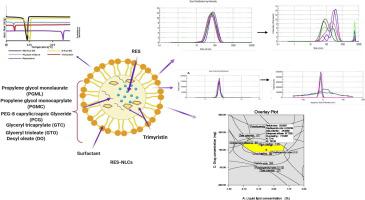Journal of Molecular Liquids ( IF 6 ) Pub Date : 2020-07-08 , DOI: 10.1016/j.molliq.2020.113734 Chahinez Houacine , David Adams , Kamalinder.K. Singh

|
Nanostructured lipid carriers (NLCs) have emerged as versatile carriers to improve oral bioavailability of poorly water-soluble drugs as well as to protect labile drugs from degradation and metabolism. Prepared by blending solid and liquid lipids, the choice of liquid lipid can have a great influence on their physicochemical characteristics and stability. The present work investigated the impact of six different liquid lipids with diverse chemical structures and hydrophilic and lipophilic balance (HLBs) on the critical quality attributes (CQAs) and storage stability of NLCs with trimyristin as solid lipid. Resveratrol (RES) was used as model drug as its low water solubility, poor bioavailability, rapid metabolism and clearance from systemic circulation restricts its clinical use despite its wide spectrum of biological activities. Liquid lipids investigated included, two triglycerides, one medium chain (C8) glycerol tricaprylate (GTC) and second, long chain (C18) glyceryl trioleate (GTO); two propylene glycol fatty acid esters, propylene glycol monocaprylate (PGMC) and propylene glycol monolaurate (PGML); fatty acid ester decyl oleate (DO) and a PEGylated lipid polyethylene glycol-8 caprylic/capric glycerides (PCG). Box–Behnken experimental design was employed to ascertain the effect of four independent factors viz. type of liquid lipid, amount of liquid lipid, amount of drug and surfactant concentration and interactions between these factors on the CQAs of NLCs as response variables viz. particle size (PS), polydispersity index (PDI), zeta potential (ZP), drug encapsulation efficiency (EE), and drug loading (DL). The relationship between various factors and responses was established by response surface methodology (RSM). The oils with higher lipophilicity C18 triglycerides (GTO) and C18 fatty acid ester DO yielded NLCs with lower PS as compared to the oils with lower lipophilicity (PGC, PGMC and PGML). Although increasing the concentration of liquid lipids had an upward trend on the PS of NLCs, its PDI was more predominantly influenced by the nature of liquid lipid. The characteristic of the liquid lipid influenced the DL remarkably which varied from 2.94 to 7.56%. The ZP of nanoparticles varied from −21.3 to −39.9 mV with liquid lipids with free hydroxyl groups and higher HLB playing a more prominent role contributing to the increase in the negative surface charge. The characteristics of liquid lipid influenced the depression of melting point of RES with maximum distortion of the crystal lattice was caused by PGMC and least by GTO. The two, long chain oleates, DO and GTO exhibited a shift of lipid peak in NLCs to higher melting points (116 and 111 °C) than the less lipophilic liquid lipids (103–104 °C). The attributes of liquid lipid also discriminate whether the particle growth during storage followed Oswald's ripening or coalescence. NLC containing GTO exhibited the highest stability in terms of maintenance of the PS and particle size distribution at 20 °C. This study provides vital insight on impact of liquid lipids and future strategy for rational design of stable NLC systems for delivery of various bio-actives for drug delivery applications.
中文翻译:

液体脂质对白藜芦醇口服白藜芦醇纳米结构脂质载体的发育和稳定性的影响
纳米结构脂质载体(NLC)已作为通用载体出现,以改善水溶性差的药物的口服生物利用度,并保护不稳定的药物免于降解和代谢。通过将固体脂质和液体脂质混合制备,液体脂质的选择对其物理化学特性和稳定性有很大影响。本工作研究了六种不同的具有不同化学结构以及亲水和亲脂平衡(HLB)的液体脂质对以曲霉毒素为固体脂质的NLC的关键质量属性(CQA)和储存稳定性的影响。白藜芦醇(RES)被用作模型药物,因为它具有广泛的生物活性,但其水溶性低,生物利用度差,新陈代谢迅速以及从系统循环中清除等限制了其临床应用。研究的液体脂质包括:两种甘油三酸酯,一个中链(C8)甘油三辛酸酯(GTC)和第二个长链(C18)甘油三油酸酯(GTO);两种丙二醇脂肪酸酯,单辛酸丙二醇酯(PGMC)和单月桂酸丙二醇酯(PGML);脂肪酸酯油酸癸酯(DO)和聚乙二醇化脂质聚乙二醇8辛酸/癸酸甘油酯(PCG)。使用Box–Behnken实验设计来确定四个独立因素的作用。液体脂质的类型,液体脂质的量,药物和表面活性剂的浓度以及这些因子之间在NLC的CQA上的相互作用作为响应变量,即。粒径(PS),多分散指数(PDI),ζ电位(ZP),药物包封效率(EE)和药物载量(DL)。通过响应面方法(RSM)建立了各种因素与响应之间的关系。与亲脂性较低的油(PGC,PGMC和PGML)相比,亲脂性较高的C18甘油三酸酯(GTO)和C18脂肪酸酯DO产生的NLC具有较低的PS。尽管增加液脂的浓度在NLC的PS上有上升的趋势,但其PDI受液脂性质的影响更大。液体脂质的特性显着影响DL,从2.94到7.56%不等。纳米粒子的ZP从-21.3到-39.9 mV不等,带有游离羟基的液体脂质和较高的HLB发挥了更显着的作用,从而增加了负表面电荷。液体脂质的特性影响了RES的熔点降低,其中晶格的最大变形是由PGMC引起的,而最少由GTO引起的。两种长链油酸酯,DO和GTO在NLC中显示出的脂峰比低亲脂性液态脂(103-104°C)移到更高的熔点(116和111°C)。液体脂质的属性还可以区分存储过程中的颗粒生长是在奥斯瓦尔德(Oswald)成熟还是聚结之后。就保持PS和20°C的粒径分布而言,含有GTO的NLC表现出最高的稳定性。这项研究为液体脂质的影响提供了至关重要的见解,并为合理设计稳定的NLC系统以提供各种生物活性物质用于药物输送应用提供了未来策略。



























 京公网安备 11010802027423号
京公网安备 11010802027423号